► Ford GT supercar driven
► We test it on road and track
► Le Mans winning, £450k + taxes
We drove the Ford GT last year, and needless to say we were impressed with the Blue Oval’s latest supercar. In fact, a lot of people were, and after demand has exceeded supply by six to one, Ford is preparing to reopen the order books, and produce a further 350 examples of the new GT.
Only one eight of those are heading for the European market, though: Not a lot, but we’ll take them.
Ford says the virtual order books will reopen worldwide on November 8, and you’ll have to submit your details to FordGT.com to be considered. If successful, you’ll be on a list for a car produced between 2020 and 2022 – so there’ll still be a significant wait.
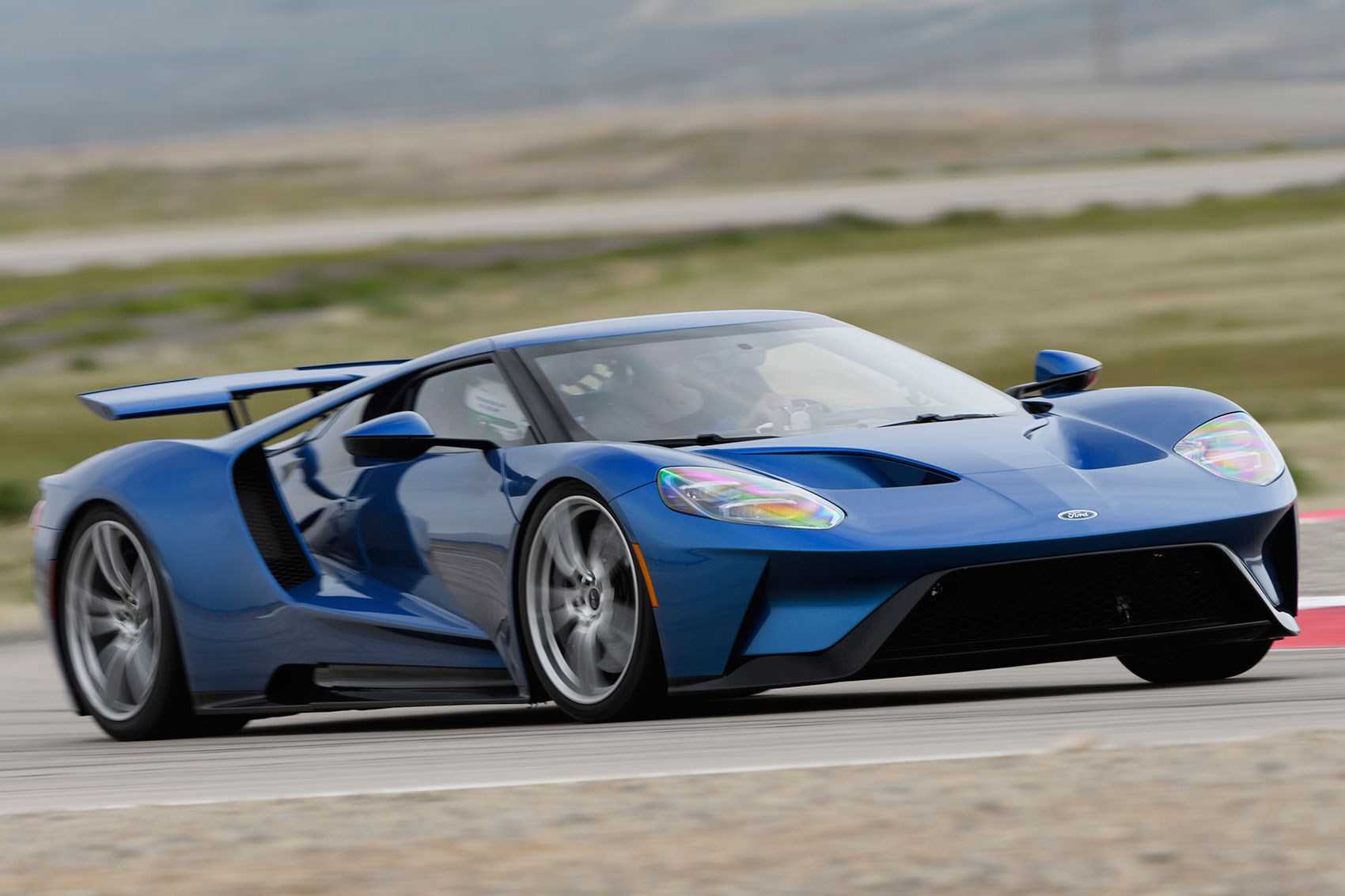
‘The response to our Ford GT has been unprecedented, with demand outstripping supply more than six-to-one,’ said Hermann Salenbauch, director, Ford Performance.
‘By extending the Ford GT production run for a limited period, we’re able to maintain the exclusivity of the ultra-desirable supercar while offering the ownership experience to a greater number of customers in addition to the 80 Ford GT owners in Europe who’ve taken delivery of their bespoke car to-date.’
Ford GT (2017) review
Almost a year after it won its class at Le Mans, over two years since the road car debuted at the Detroit show, we’ve finally driven the Ford GT on track at the Ford Performance Racing School in Utah, and on twisting public roads.
The first customers – having passed an application process and agreeing not to sell their cars for a couple of years, maybe three, depending on who you ask – have already taken delivery.
They’ll have paid at least £450k before options and taxes, with 250 cars per year planned for the next four years.That’s double the price of a Lamborghini Aventador S, but the first couple of years’ production is already snapped up
Didn’t Ford need to sell a road car before they raced?
Ah, yes, that. Ford received special dispensation to race at Le Mans before the GT entered production. The fact that the GT raced before it was a road car is quite crucial: the GT was designed specially to win the LMGTE class at Le Mans – the top road-car-based class – to mark 50 years since Ford beat Ferrari to top honours at La Sarthe with the GT40 driven by Bruce McLaren and Chris Amon.
Development work started only in 2013, led by former Mustang chief engineer Dave Pericak and his team at Ford Performance, shortly after the ‘Project Silver’ Ford Mustang Le Mans programme was canned because it was drifting so far away from the production car design.
Hear Dave Pericak talk about the Ford GT on video
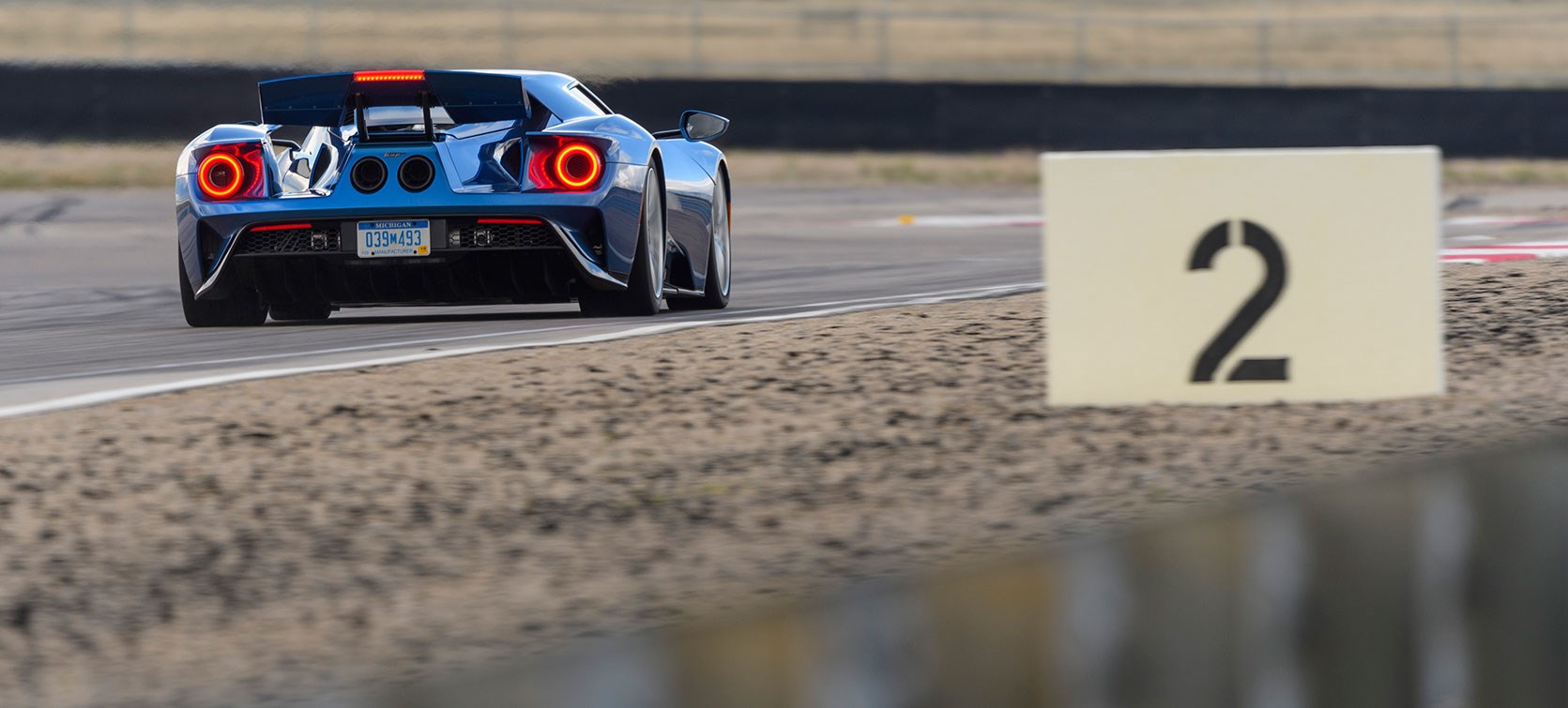
Pericak and his team started fresh with a clean-sheet design, determined to create the ultimate GT to win at Le Mans – the suspension, the bodywork, the structure, all of it is far more exotic than a Ferrari 488’s or Porsche 911’s. It’s a racecar that’s become a road car, not the other way round, but the two were developed synchronously.
What’s so special about the Ford GT spec, then?
The Ford GT is built around a carbonfibre tub, the 45 pieces that comprise it bonded together, and that bonding said to soak up any small variability in production. All the body panels are carbonfibre too. The dry weight of the ‘Competition Pack’ car –without air-con, and with carbon wheels and titanium exhaust – is 1385kg, around 100kg more than a McLaren 720S. The regular Ford GT adds a further 60kg, and that’s the car we’re driving.
Similar to LaFerrari, the seats are fixed to the carbonfibre tub and don’t move, though the back rests do recline – they’re not actually moulded into the tub. Instead of moving the seat, you adjust the pedal box and steering column to suit. Virtually all controls – from drive modes to wipers and indicators – are combined in the steering wheel.

The rollcage is built into the upper structure. You can’t see it because it’s hidden behind trim that looks like most production cars’, but it requires only add-on components to turn into the racecar’s full cage.
The suspension is by double-wishbones, but there’s a pretty radical twist on the inboard pushrod set up. The pushrod acts on two springs: one, a torsion bar, is active all the time; the second, a conventional spring, is active until you select Track mode. At that point it’s hydraulically locked out by an actuator; it becomes solid and the spring rate effectively doubles.
The pushrod also acts on the DSSV adaptive dampers, which are actually mounted at the front of the cockpit, out of sight. All this has freed up more space to manage airflow under the car.
With the rear wing deployed, active vents open up in the lower front splitter to channel air through vents behind the front wheel arch, increasing front downforce. When the wing drops down, those front vents close, reducing front downforce to suit.
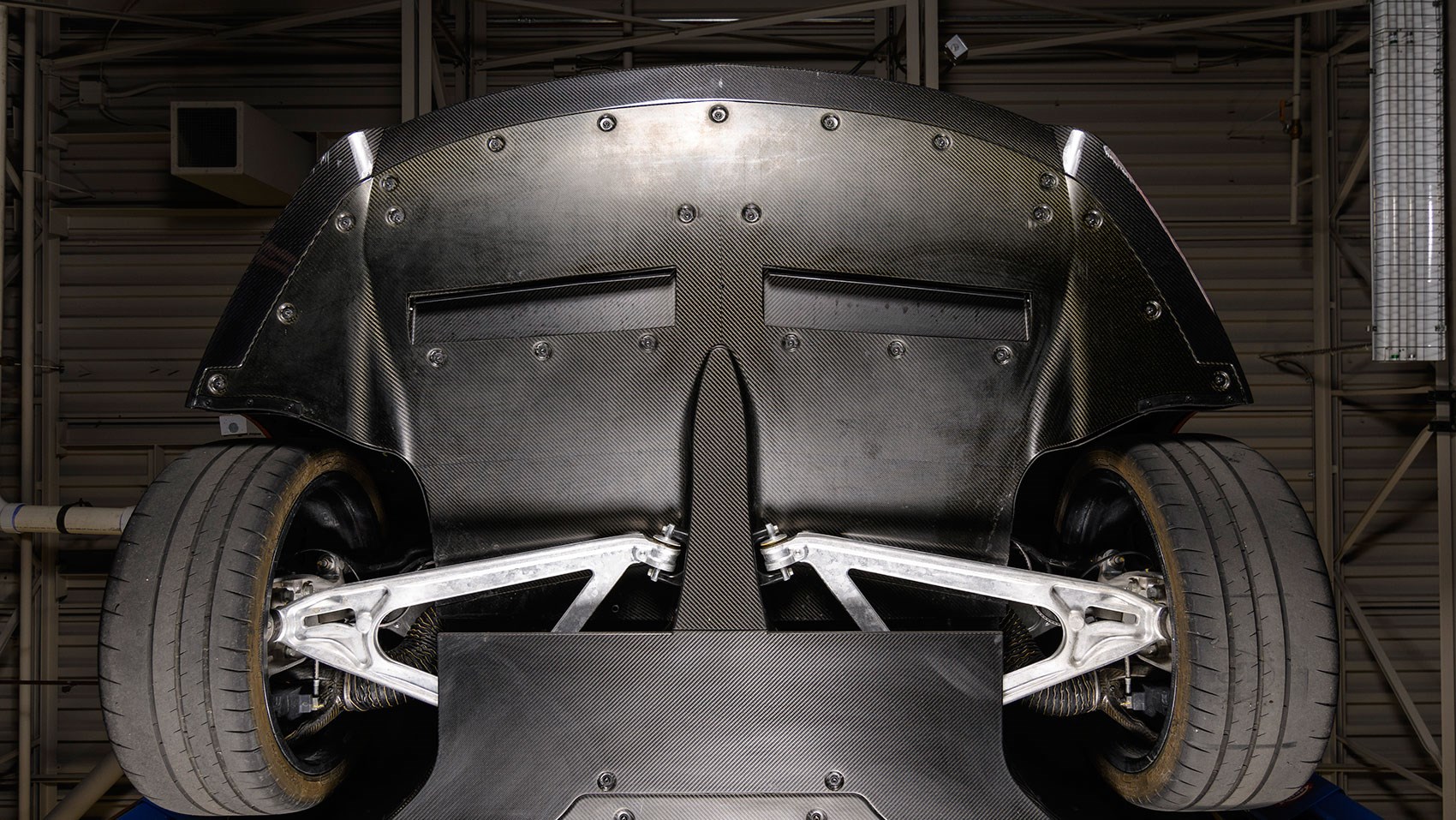
The floating buttress design is the stand-out feature of a beautifully technical and highly evocative body. Not only do the buttresses help channel air along the flanks to the rear wing, they also carry air inside them, piping it from the intercoolers to the engine inlet.
A 3.5-litre V6 Ecoboost was key in creating the body’s teardrop shape, the small engine allowing the design team to tightly package the bodywork around it. Dry-sumped, the all-aluminium engine produces 647bhp and 550lb ft.
What’s the Ford GT 2017 cabin like?
It’s tight and tricky to get into, a by-product of Ford designing a car with the smallest frontal area in its class to reduce drag. The low roof, thick carbonfibre sill and dihedral door all hinder access, and when you’re inside there’s very little headroom – at six-feet-one, I had an inch of headroom and had to recline the seat a little to snick my head under the rooflining when wearing a crash helmet. Rubbing shoulders with your passenger is inevitable. The seats are high on support, but while the bases are comfortable, the cut-outs in the seatbacks may prove irritating if you’re double-stinting.
Unlacquered carbonfibre is everywhere, including the instrument panel, which is integral to the structure. It creates a serious, functional, racey feel and adds a sense of occasion, but it’s not in the least luxurious. Leather or Alcantara trim adds some interest, but you’ll still notice the dated sat-nav and the parts-bins controls. Some of the trim on the door casing’s arm rest was already deteriorating on one of the test cars.
How does the GT supercar feel on track?
Very impressive. There are five drive modes to select: Wet, Normal, Sport, Track and V-Max. Choose Track and the suspension drops instantly from 120mm to 70mm (making the GT just 1.8 inches taller than the original GT40’s 40 inches at the top of the windscreen) and the rear spoiler extends on its hydraulic struts. It’s a fantastic bit of theatre that makes the McLaren P1’s transformation to max-attack mode look a little long-winded. Downforce increases from a max of 45kg to 154kg at a stroke.
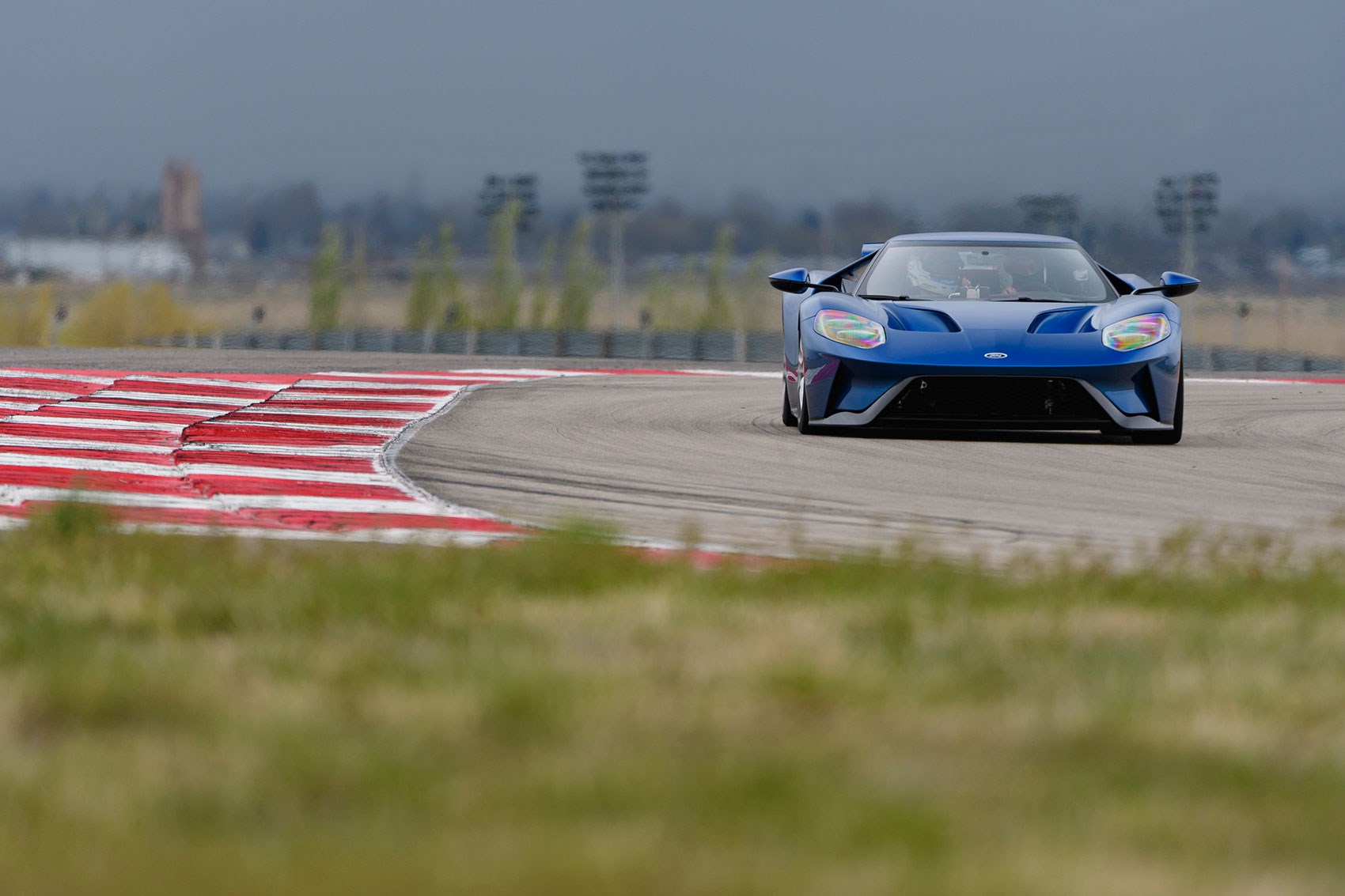
Despite the intimidation you may feel looking at the GT or sitting in its serious-feeling interior, it’s easy to settle into driving it quickly. The chassis feels flat and composed, hungry to change direction with a flick of your wrists, the suspension far from too stiff despite the massive increase in spring rate with Track mode.
It’s blindingly fast, obviously: 0-62mph takes a quoted 2.8sec, while top speed is a claimed 216mph.
Browse Ford cars for sale
There’s a little fuzziness to the brake pedal at first, but push past that and the carbon ceramics are easy to modulate, and wipe off speed like a parachute; I braked as late as I dared and still felt I could have gone much deeper.
The steering is hydraulically assisted and feels precise and quick-witted from the second you wind it off-centre. It’s progressive, relatively heavy – if far from too heavy – weighting giving you real confidence to lean on the front end. When you do there’s deep reserves of grip from the 20-inch Michelin Pilot Cup Sport tyres with their huge, almost slick shoulders. The confidence that provides allows you to quickly work up to the point where the front grip is starting to bleed very progressively into light understeer.

Naturally, a car with 647bhp and 550lb ft feels extremely rear-biased, and while there’s an impressive level of traction, there’s more than enough torque to overwhelm the rear tyres; you have to feed in the long travel accelerator gently out of tighter corners. Lift the throttle in faster turns and the GT quickly tightens its line, but its progressive and well-balanced. Get too excited and the stability control still gives you time to tidy up your exuberance; nicely judged.
How about the 3.5-litre V6 engine?
Let’s get the bad stuff out of the way first. 647bhp and 550lb ft is a lot of performance, but the game has moved on since we first saw the Ford GT. The McLaren 720S, for instance, makes 710bhp and 568lb ft but costs ‘just’ £209k.
Then there’s the fact it’s a turbocharged V6, which can’t hold a candle to the Italian exotics in terms of vocal range – peak power is all done by 6250rpm – and sounds rather gruff, especially at idle; think more Noble than supercar nobility. But there are good points: throttle response is very sparky, giving you a great sense of connection to the rear axle, every flex of ankle yielding a response; no turbo mush here.

From Sport mode, you get an anti-lag function that keeps the boost spinning without burning fuel, for rapid-response to make a Westminster firearms team look dozy. And when you wind up the revs, the soundtrack steps up a notch, sounding exciting and much more sophisticated than the idle note leads you to expect.
And this is a fast car, with good driveability low-down, excellent mid-range thrust and a strong top end. We noticed differences in the two cars we drove, though. One seemed to boost hard from 2700rpm, the other much further into the threes, and while the 2700rpm car got a second wind at 5500rpm and accelerated with some proper ferocity to the redline, the other was much more progressive and less dramatic.
The V6 is paired with a seven-speed dual-clutch transaxle. It shifts quickly, but there’s a woolly edge to the engagement, and downshifts aren’t always delivered when you ask; those Le Mans rivals Ferrari and Porsche give you sharper shifts for a more satisfyingly mechanical feel.
What’s the Ford GT like on the road?
There’s still a lot to like: the suspension is impressively compliant in its softest setting while still maintaining great body control, and the stuff that stands out on track does translate to the road. There’s a quick-witted front end, bags of front end to lean on in corners, great brakes and a poised, rear-biased feel. It flows down a challenging road very nicely indeed.
But it falls down in terms of refinement, and feels very much like a racecar put on the road. Transverse ridges thunk through the carbon chassis, there’s buzzy resonance through the cabin, some frequencies that build up through the steering add more to NVH than they do to feel, and the active rear wing slams back into the bodywork so fiercely you wonder if it hasn’t fallen off.
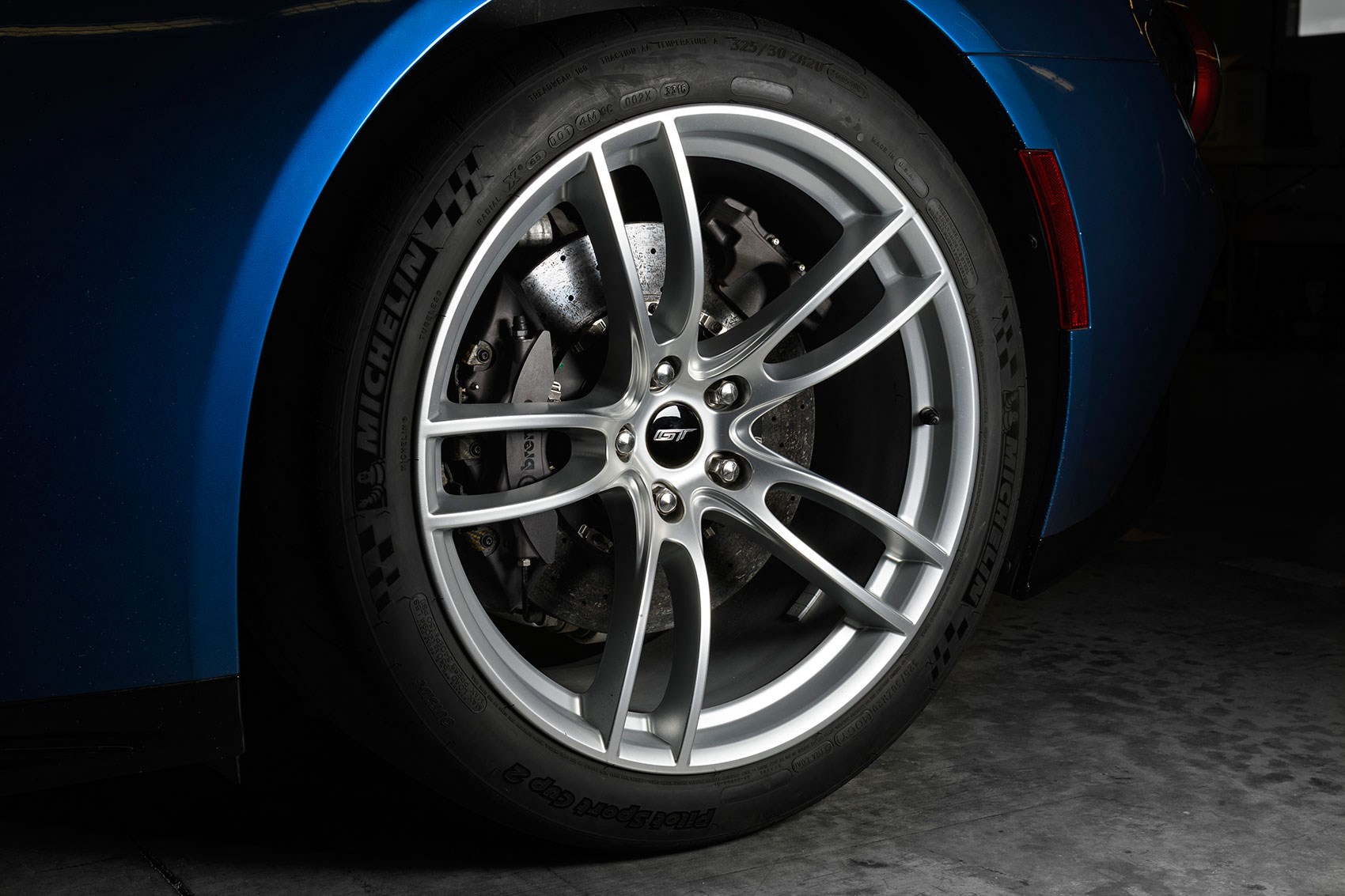
Strangely, I also felt the GT’s lack of pace relative to the opposition more keenly on the road – perhaps because Track mode has more aggressive throttle mapping, perhaps because you’re leaning so hard on the chassis on track that you couldn’t use much more performance anyway, where you get more straight-line time on the road. It’s quick, no doubt about it, but rivals have taken it to another level again.
Verdict
The Ford GT is an exciting, enjoyable car to drive, and one that’s quite incredible to see a mainstream company like Ford producing. The beautiful design, the carbonfibre construction and clever suspension and aerodynamics, the fact that it’s pretty sensational to drive on track and thrilling on the road too – it should be celebrated for all that. But it’s also incredibly expensive, has a V6 engine that can’t come close to the excitement of a Ferrari V8 or Lamborghini V12 either in terms of performance or soundtrack, and its racecar origins are just a bit too obvious on the road, with vibrations, clunks and odd noises that spoil refinement without really adding any sort of hardcore depth to the experience.
Some might argue the rough edges are all part of the Ford GT’s racecar-for-the-road appeal, but at £450k-plus, customers should expect more, and I suspect smoothing off those edges would make the GT not only easier to live with, but better to drive too.
Read more Ford reviews